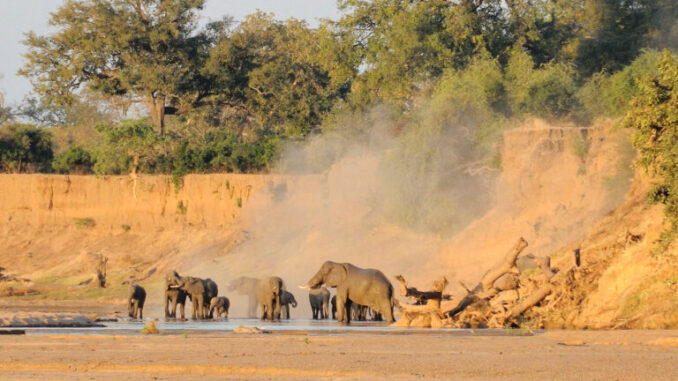
[ad_1]
Elephants are known to be “ecosystem engineers,” altering habitats to suit their own needs, but this sometimes comes at a cost to other species. Hedging, or stem snapping, is the term used to describe how elephants (Loxodonta africana) reduce dominant trees to low-level shrubs, bringing the trees’ leaves within easy reach of mother-and-calf herds while depriving other animals of homes and food.
“They [elephant bulls] do work an area over time [and] reduce all the trees to a certain sort of height,” says Tim O’Connor, lead author of a recent study that shines a light on the hedging of dominant hardwood trees known as mopanes (Colophospermum mopane) in Zimbabwe’s Gonarezhou National Park, in the southeastern corner of the country.
“They snap the stems; [the trees] grow as a thicker, smaller plant and therefore give it a hedge appearance.”
Mopane hedging by hungry, constrained elephants has been well documented in other national parks in Botswana, South Africa and Zambia.


At the study site in the north of Gonarezhou, near to where the Runde River flows beneath ancient sandstone cliffs, O’Connor and colleagues found that elephants had snapped more than half of all the trees measuring some 10 meters (33 feet) in height. Although the canopy volume of the coppiced mopanes remained healthy, it severely compromised living conditions for animals that make their homes in tree cavities: birds like hornbills, rollers, chats and barbets, reptiles like lizards, skinks and snakes, and mammals like squirrels.
The coppiced trees still produce seeds and seedlings, but most of the seed production is from the few surviving larger trees too big for elephants to snap. Those trees, however, are invariably stripped of their bark by bull elephants as a food substitute when the mopane shrubs have lost all their leaves at the height of the dry season. Without bark, they slowly die.
O’Connor says that what his team has observed here “is certainly representative of large expanses of mopane woodland in Gonarezhou and elsewhere.”
Gonarezhou currently has around 11,000 elephants, or more than two elephants per square kilometer (five elephants per square mile), across its 5,000-km2 (1,900-mi2) expanse. Scientists have observed that elephants have a telling impact on woodlands wherever their density exceeds just 0.5 elephants/km2 (1.3 elephants/mi2).
The bull elephants who do most of the damage to woodlands would far rather graze on the lush short grass of floodplains, or in thick reedbeds alongside rivers, experts say.
Such places are plentiful in neighboring Mozambique’s Zinave and Banhine national parks, located just 50-100 km (30-60 mi) east and southeast of Gonarezhou. These are parks the elephants should in theory have access to, as they and Gonarezhou are part of the Greater Limpopo Transfrontier Conservation Area (GLTFCA).


Created in 2002 by the governments of Mozambique, South Africa and Zimbabwe, the GLTFCA includes South Africa’s Kruger National Park and the adjoining Limpopo National Park in Mozambique, as well as Zinave and Banhine. The latter two parks have a combined area of around 11,000 km2 (4,247 mi2), more than double that of Gonarezhou.
“One of the motivations [for the GLTFCA] was that the wildlife of Mozambique would be restocked through migration from both Zimbabwe, i.e. Gonarezhou, and South Africa, i.e. Kruger,” O’Connor says.
While there’s been a major influx of wildlife, including elephants, from Kruger into Limpopo National Park, it hasn’t widened the horizon for Gonarezhou’s elephants.
To travel south, they need to first traverse the Sengwe wildlife corridor, which runs through a densely populated part of Zimbabwe’s Chiredzi district, then ford the Limpopo River — which is often in flood in the summer months of December-March.
And then to travel east into Mozambique, the elephants must face trophy hunters.
“There’s hunting happening in those areas so it’s possible that there could be a ‘landscape of fear’ that has been created,” says Bob Mandinyenya, an ecologist and head of scientific services at the Gonarezhou Conservation Trust.
Mandinyenya, who joined the trust in 2019, has been tracking 26 elephants fitted with satellite collars as part of a long-term project. He and his colleagues have found that some of Gonarezhou’s “explorer” elephants have been on the move, potentially opening up routes to South Africa and Mozambique that others could follow.
“Any movement that shows potential corridors or connectivity with other neighboring protected areas is quite exciting,” Mandinyenya says.

Among Gonarezhou’s most intrepid elephants were two bulls that headed south, crossed the Limpopo River into South Africa’s Kruger National Park, and later returned to Gonarezhou; an elephant cow and her herd that trekked across to Kruger and spent a year there before moving next door to Mozambique’s Limpopo National Park; and a bull elephant that migrated eastward for 60 km (37 mi) into neighboring Mozambique toward Banhine National Park for three years in a row.
The latter elephant would leave Gonarezhou as the rains started in December and return several months later. Mandinyenya says he believes the elephant was lured by the ripening fruit of marula trees (Sclerocarya birrea) that it had discovered somewhere across the border.
Tragically, though, the marula-munching bull was killed earlier this year in Mozambique, just 13 km (8 mi) from the Gonarezhou park boundary, by poachers targeting its tusks. “We thought he would show us the not-yet-known corridor between Gonarezhou and Banhine,” Mandinyenya says.
The ecologist has tracked other elephants, both bulls and cows, just across the border onto privately owned safari concessions. The elephants seem to have worked out which of these properties — probably ones whose owners engage in conservation measures such as anti-poaching patrols — are safer than others.
If conservation efforts were applied uniformly across all the properties adjoining Gonarezhou, it would likely encourage elephant movements deeper into Mozambique, Mandinyenya says.

Beyond the conservancies, however, anecdotal evidence suggests that human settlements pose another obstacle for the animals that try to traverse the two districts of Massangena and Chicualacuala to reach Zinave and Banhine. Although the districts are sparsely populated, most people live in linear patterns alongside roads or rivers near to those two parks, creating barriers that elephant cows and their herds, especially, would be reluctant to cross.
“We need a wilderness area that is continuous from Gonarezhou to Banhine without people staying there, but at the moment there isn’t,” Mandinyenya says. “The human population will continue to increase, so if we don’t take the opportunity now, as time goes on the complexities will get even more complex to deal with.”
That’s a view O’Connor shares. On a continent where available habitat for elephants is shrinking, he points out, the GLTFCA offers a rare opportunity to reduce elephant pressure on Gonarezhou’s woodlands, while helping to restock places like Zinave and Banhine in support of Mozambique’s tourism industry.
“It’s all there to make a success story,” he says.
Citation:
O’Connor, T., Ferguson, A., Clegg, B. W., Pallett, N., Midgley, J. J., & Shimbani, J. (2024). Emergent trees in Colophospermum mopane Woodland: Influence of elephant density on persistence versus attrition. PeerJ, 12, e16961. doi:10.7717/peerj.16961
This article by Ryan Truscott was first published by Mongabay.com on 28 June 2024. Lead Image: Elephants on the Runde River, Gonarezhou National Park, Zimbabwe. Image by Andrew Ashton via Flickr (CC BY-NC-ND 2.0).
What you can do
Help to save wildlife by donating as little as $1 – It only takes a minute.
[ad_2]
Source link

Leave a Reply